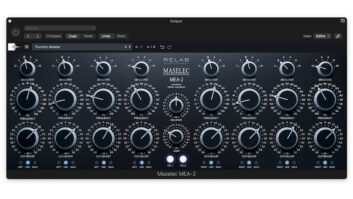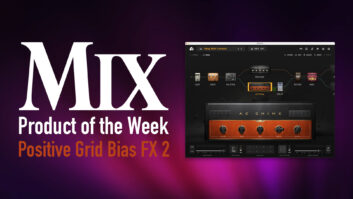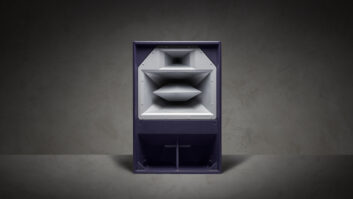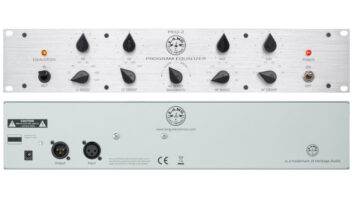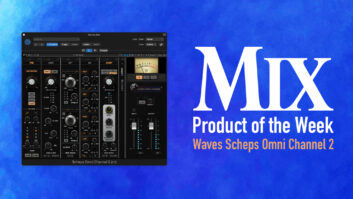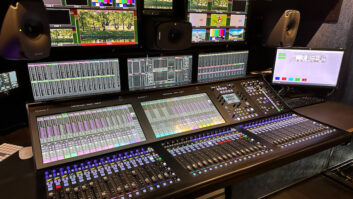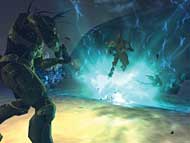
Photo: Courtesy of Microsoft
“The fun thing about interactive media and games is that it’s still a relatively new medium,” says Marty O’Donnell, audio director of Bungie Studios, developers of the popular Halo Series of first-person shooter science-fiction video games. “Not only are there all sorts of technological [developments] advancing the field almost on a monthly basis, the aesthetics of the medium haven’t really been established yet. It’s sort of like being at the beginning of the film industry, where people are realizing, ‘Hey, we can move the camera around,’ or, ‘We can put on this zoom lens to go in and out.’ All that kind of cool stuff is happening in the gaming industry right now, where new things are constantly being invented that will change how games look, sound and feel to the player.”
O’Donnell, who works on both sound design and music for Bungie titles, has a long background in audio. After receiving his master’s degree in music composition from USC, he spent nearly two decades in commercial music production in the Chicago area. He always enjoyed video games as a hobby, “but the production values, particularly the audio, really seemed to be lacking; they were so constricted,” he says. “Then in 1993, the son of a friend of mine saw my studio and he said, ‘I see you’re interested in computer games. I have friends who make computer games.’ This is an 18-year-old kid. So that night he brought a beta version of a new game to my house — it turned out to be Myst; no one had seen it yet. And it was, of course, really, really cool. So I told him I needed to meet his friends, who were in Spokane [Wash.], and I did. I met Robin and Rand Miller [developers of the game], and I eventually got to work on the sequel to Myst — Riven.
“In those games, they were really doing something new,” he continues. “They seemed to understand that you could create a much more immersive experience in interactive entertainment by not relying on some of the conventions that had been built up in games up to that point — electronic-y, nonstop looping music. Suddenly, you had this very cinematic and surreal experience and excellent production values. It was clear that that was the direction games were headed, so I decided to make the jump.”

Marty O’Donnell is audio director of Bungie Studios, creators of the Halo franchise.
O’Donnell took a job with Bungie in 1996 and has worked on most of the company’s big games, including Myth (1 and 2), Oni and the Halo franchise. The hotly anticipated Halo 2 is being released early this month. (In 2000, Bungie was acquired by Microsoft in what game industry analysts agree was an attempt to lock up one of the more sophisticated game developers to create product for the company’s proprietary Xbox system. Bungie’s offices are located in Microsoft’s headquarters in Redmond, Wash.)
The Halo games are set in the distant future, when mankind is being threatened by various unsavory alien-types known collectively as The Covenant, which includes such sub-groups as Grunts, Jackals and The Elite — all gnarly dudes. Our character is known as the Master Chief, and basically it’s up to us to blast away the alien scum over the course of a number of different game levels using all sorts of advanced weaponry and assorted vehicles. According to O’Donnell, the graphics and the audio in Halo 2 have taken a huge leap over their mega-popular predecessor: For the first time, he’s been able to utilize the Xbox’s discrete 5.1 capabilities to the fullest.
“I think surround sound works better in a first-person game than it does in movies because you are that person in the game,” O’Donnell says. “They have a field of view, but they’re also moving through space, so things are behind them all the time and all they have to do is turn around and they can look at and hear them. Audio is one of the best ways to bring that to life, and we can do so much more crazy surround sound stuff because of that first-person camera perspective.
“Everything has been turned up to ‘11’ on Halo 2,” he continues. “There’s more detail and more surround sound. I’m actually doing music that I’ve created in 5.1. I didn’t have any of that in Halo. I think we went from about 8,000 lines of dialog to about 17,000. The story is more complex and there are more characters. There are also more weapons, more vehicles and it’s a much richer experience. For example, if you’re driving the warthog [vehicle], the engine is in surround and the wheels are actually contacting whatever surface you’re on, so it knows if you’re in water, on sand or gravel, and when you skid on that, you get the right sounds. When you do damage to the vehicle, fenders fall off and you hear metal hitting sand or whatever. All those little details have been fleshed out. It’s just more realistic all the way around.”
O’Donnell and his two fellow sound designers, C. Paul Johnson and Jay Weinland, do most of their sound work using a combination of Pro Tools and BIAS Peak, a 2-track editing program for the Mac. “We do all of our dialog work in Pro Tools,” O’Donnell says, “and I do all my music in Digital Performer and Pro Tools. Production-wise, I do all the normal stuff: I record live orchestra or I do a bunch of cool MIDI tracks and record them in Digital Performer and mix them in Pro Tools.”
At this point, all of the game audio is 16-bit/44k, “quite a change from when I started working in the game industry in 1996 and the sound was all 8-bit and everybody sounded like they were talking through a cheap radio because there was so much distortion,” O’Donnell recalls. “But I wanted, and the guys at Cyan [makers of Myst] wanted, to do things better, so [on Riven] we did it 16-bit stereo, 22k, and we used the new ADPCM compression, which was a way of compressing the sounds about four-to-one; that really helped the quality. In Halo, the compression is pretty much the same. Xbox has really good compression algorithms built-in, so it doesn’t cause the CPU to work to decompress sounds.
“We’re throwing hundreds and thousands of files at the engine,” he continues. “The mono files can be something as simple as a shell casing dropping on concrete or bouncing on dirt. And the game engine itself is keeping track of where this audio is happening in 3-D space, so every piece of audio is essentially on its own track with its own joystick, but it’s automatic. Once you have an object in the X/Y/Z space of a 3-D environment, not only is it being kept track of as an object visually in 3-D space, but we can aurally keep track of it, too, so the audio is being sent to the proper speakers based on where it is existing in space. So when something blows up and a rock flies from the front left to the rear right, the game engine is actually keeping track of that rock and its position and adjusting accordingly to the proper sound perspective. Really, as the player, you’re making the surround happen.”
For mixing, O’Donnell will sometimes go to Studio X in Seattle and work on its SSL console. “If I’m in Chicago, my friend Mike Salvatore still has a couple of studios there that I’ll use, including a ProControl studio that’s really nice. Then we also did some work in L.A. on an 02R, and my studio here has a Mackie HUI. Mine is a project studio that wraps around me as I sit in my chair. I’ve got Pro Tools, a HUI and a Kurzweil, and Genelec monitors — I’m ready to go!”
The actual implementation of the sound into the game is facilitated by “tools given to us by [Microsoft] DirectSound and the Xbox, because they work with Dolby and have the Dolby chip in there that allows the game engine to control where the sound goes. The key is that there is real-time Dolby encoding and decoding, which I didn’t even think was possible a few years ago. You’re throwing all the sounds at the engine and it’s spitting it out in real time, with no delay, to six discrete channels. That’s an amazing accomplishment. I have to hand it to the guys at Microsoft and Dolby: They worked together and figured out how to do that with a chip. It makes it so much easier.”
Still, O’Donnell is aware that many people playing Halo 2 won’t have a full 5.1 setup, “so when I’m mixing, I’m constantly switching from 5.1 to stereo to see how it’s changing. And we do some cheating [for the surround mix], too: I’ll take some stereo ambient sounds and stereo music and force -6 dB or -8 dB of the same signal into the rears, so it sets up this nice environment where all speakers are humming, and then we’ll also have lots of discrete sounds happening all around you.
“But the Xbox has automatic fold-down if I tell it that I’m playing stereo. And, hopefully, not too much of the detail is lost; obviously, the perspective isn’t quite the same. Otherwise, if you do have the 5.1 [setup], we just have to hope that you’ve got them plugged in correctly. Otherwise, it’s going to be pretty disorienting.”
Blair Jackson is Mix’s senior editor.


